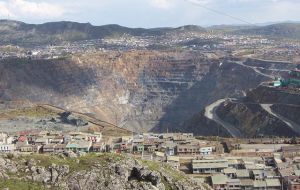MercoPress. South Atlantic News Agency
WHO sponsored research helps identify heavy lead contaminated areas in Peru
 High levels of lead in the Cerro de Pasco soil, a historic mining town in the Andes
High levels of lead in the Cerro de Pasco soil, a historic mining town in the Andes Countries – especially those with a long mining history -- can substantially reduce lead poisoning in children by mapping contamination levels in the soil to identify high-risk areas and by taking measures to keep children away from those areas, according to a study published this month in the public health journal, the Bulletin of the World Health Organization.
The study compared lead contamination levels in the soil in and around two mining areas in Peru, one of the world’s top producers of silver, copper, gold, zinc and lead. It found dangerously high levels of lead in the soil of Cerro de Pasco, a historic Andean mining town, where copper mining continues. Levels were lower in Huaral, which has a modern mine and ore processing plant.
“The worst cases of mining-related childhood lead exposure in Peru and similarly affected countries in Latin America, Africa and Asia can be avoided at relatively low cost by systematically mapping hot spots for lead in soil in mining towns and using this information to prevent further exposure,” said Dr Alexander van Geen, the first author of the study and a research professor at the Lamont-Doherty Earth Observatory of Columbia University in New York.
Exposure to lead during early childhood results in lower intelligence and behavioural problems. “The best way to tackle the problem is to prevent it in the first place, by stopping children from ingesting soil contaminated with lead,” Van Geen said, adding that this can be done by fencing off high-risk areas and, in severe cases, by removing and replacing contaminated soil or relocating families living in highly contaminated areas.
Children with severe lead poisoning are treated with chelation therapy (the use of chemical compounds to remove metals from the body) but it is not always effective or available in countries where the problem is most acute and it does not reverse damage to the brain.
Lead exposure is estimated to account for 0.6% of the global burden of disease, according to WHO estimates and, according to a 2011 review by the WHO/Food and Agriculture Organization Joint Expert Committee on Food Additives, there is no safe level of exposure to lead. Prevention of exposure is, therefore, imperative.
To help countries, such as Peru, struggling to address these problems, the study shows that lead contamination is not evenly distributed and it describes a method for identifying the areas of high lead contamination, where children should not live or play. The method is based on the use of a hand-held device -- an X-ray fluorescence analyser -- to measure lead levels in the soil.
Lead exposure in many parts of the world is decreasing thanks to the phasing out of leaded gasoline, the banning or restriction in the use of leaded paint, and measures to control emissions of lead from industrial processes.
“These measures have not been universally adopted, however, and there are still many areas of high environmental contamination with lead, in particular because of poorly-controlled mining, smelting, manufacturing and recycling activities,” said Joanna Tempowski, a scientist at the Evidence and Policy on Environmental Health unit in the World Health Organization (WHO).
WHO and the United Nations Environment Programme have established the Global Alliance to Eliminate Lead Paint, a campaign to phase-out the manufacture and sale of paints containing lead and, eventually, to eliminate the risks that such paints pose. The Blacksmith Institute, an international non-profit organization, has identified over 500 sites globally polluted by lead, with an estimated 16 million people at risk of exposure.




Top Comments
Disclaimer & comment rules-

Read all commentsI remember being a part of the campaign in the UK to get lead removed from petrol. Ralph Nader's era.
Dec 06th, 2012 - 03:27 pm 0It's not so much that people 'eat' the contaminated soil, they eat veg. that has been grown in it.
Chelating agents such as EDTA are good - they 'grab' the heavy metals in the gut;
I remember when I was young, we used Kaolin & Morphine for stomach ailments - the kaolin (clay) additionally bound the heavy metals which then passed through the body rather than becoming retained as poisons within. The morphine is now a Banned Substance for over-the-counter sales.
The mapping of contaminated land is one thing; the removal of human activity from such land is altogether another thing!
Decontamination is horrendously expensive.
Slums/favelas develop unchecked on contaminated land unless there is profoundly good local, regional and national governance.
This cries out for joined-up-government-thinking.
Commenting for this story is now closed.
If you have a Facebook account, become a fan and comment on our Facebook Page!